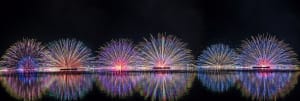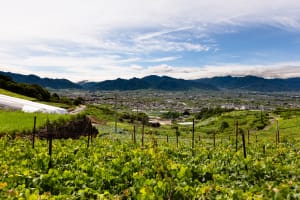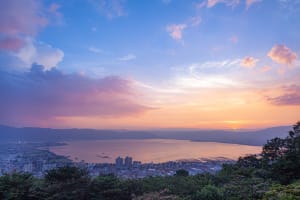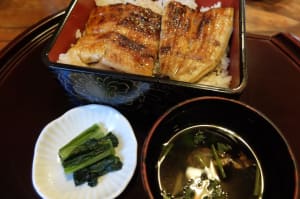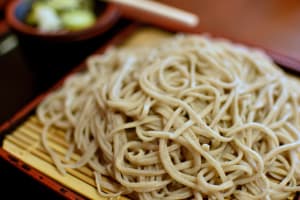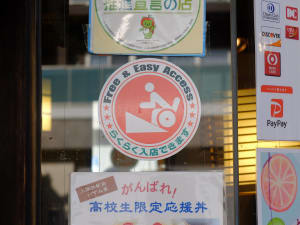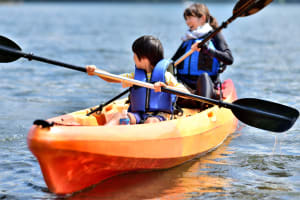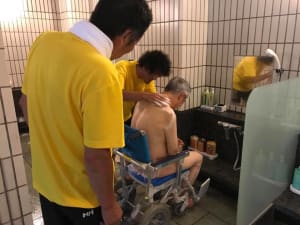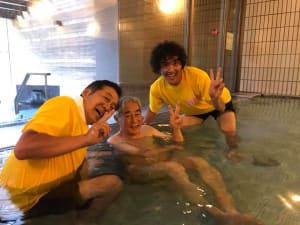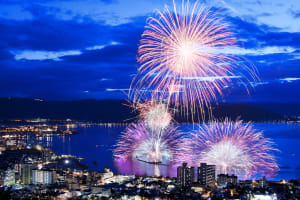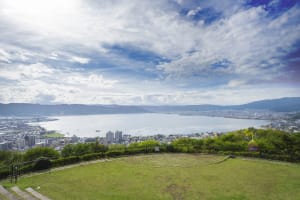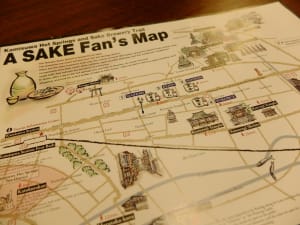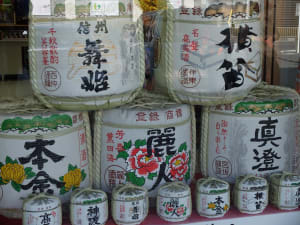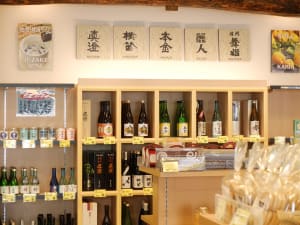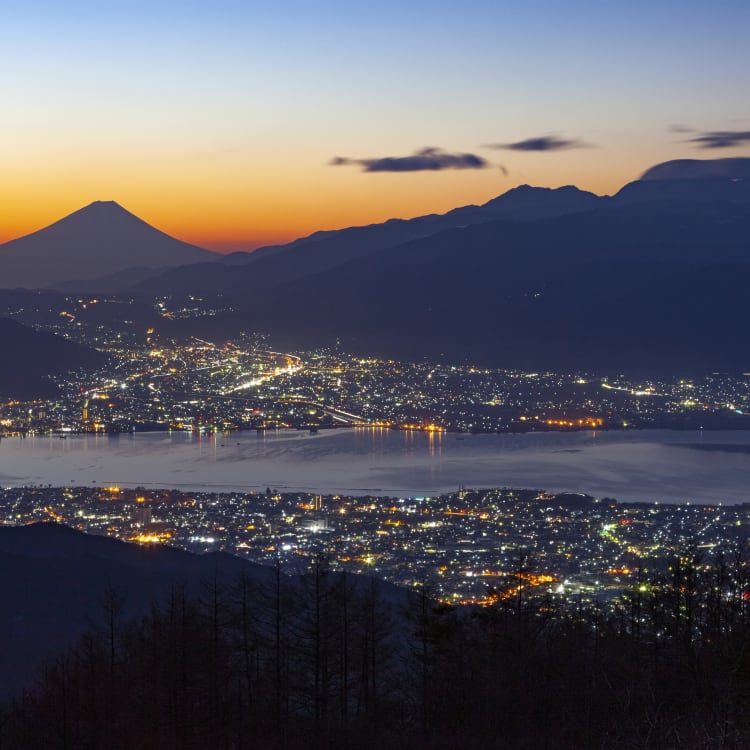
Take a wheelchair-friendly tour of Lake Suwa, packed with hot springs, firework shows, sake, art, and culture. Two days of barrier-free fun at Lake Suwa Lake Suwa in Nagano is just 150 minutes from Tokyo via limited express train. Kami-Suwa Station is surrounded by many tourist spots, all within short distances of each other. This laid-back itinerary gives you a chance to immerse yourself in art and cultu
Easily accessible from Tokyo, Lake Suwa is a convenient option for wheelchair users looking to make an overnight trip. Many facilities incorporate universal design, so expect to have a memorable and hassle-free cultural experience.
Day 1: Take the train to Kami-Suwa Station where you can enjoy boat cruises, canoeing, and firework displays. The area has accessible bathhouses, and you can even hire assistance to help you take a hot spring bath.
Day 2: Explore the art galleries and museums that line the lakeshore, followed by a visit to historic local breweries.
Fast Facts
Required time: Game + 2 days
Distance traveled: app. 400 km
Express train, train, taxi
Starting point: Tokyo
Final destination: Tokyo
Day 1
Hot springs and marine activities at Lake Suwa
Take a wheelchair-accessible express train to Lake Suwa, where you can enjoy marine activities, hot springs, and fireworks.
Accommodation: Tokyo area
Tokyo Station or Shinjuku Station
| 150 min Limited Express Azusa
Kami-Suwa Station
| Walk
Lunch
| Walk/Taxi
Hotel at Kami-Suwa Onsen
| Walk/Taxi
Lake Suwa
Accommodation: Kami-Suwa Onsen area
Accommodation: Tokyo area
Tokyo Station or Shinjuku Station
| 150 min Limited Express Azusa
Kami-Suwa Station
| Walk
Lunch
| Walk/Taxi
Hotel at Kami-Suwa Onsen
| Walk/Taxi
Lake Suwa
Accommodation: Kami-Suwa Onsen area
Journey to Lake Suwa
Lake Suwa is accessible from Tokyo via highway bus or train, but the most convenient way to go there is by the limited express train Super Azusa. Many of the train cars have accessible seats which allow you to affix your wheelchair with a belt, as well as spacious toilets. All seats on the Super Azusa are reserved. You can pick up your tickets at the ticket machines or JR counters. If you have a JAPAN RAIL PASS, you can also reserve your seat online.
The Super Azusa can be boarded from Shinjuku or Tokyo Station. Once you’re past Tokyo’s suburbs, enjoy the gorgeous mountainous views from the train windows. You’ll speed past the Kofu basin—Japan’s wine country—and if you’re lucky, you might catch a glimpse of Mount Fuji towering over the vineyards and peach gardens. Further down, you can take in views of the magnificent Mount Yatsugatake and the Southern Japanese Alps, a popular hiking destination.
The journey to Kami-Suwa Station, the nearest station to Lake Suwa, takes about two and a half hours.
The Super Azusa can be boarded from Shinjuku or Tokyo Station. Once you’re past Tokyo’s suburbs, enjoy the gorgeous mountainous views from the train windows. You’ll speed past the Kofu basin—Japan’s wine country—and if you’re lucky, you might catch a glimpse of Mount Fuji towering over the vineyards and peach gardens. Further down, you can take in views of the magnificent Mount Yatsugatake and the Southern Japanese Alps, a popular hiking destination.
The journey to Kami-Suwa Station, the nearest station to Lake Suwa, takes about two and a half hours.
Relive scenes from a famous anime
Lake Suwa is located in the heart of Nagano Prefecture. Surrounded by the soaring Southern Japanese Alps, the lake is a recreational hub offering marine sports, hot springs, and firework displays.
Boat cruises are available from spring to autumn, and in the winter you can try ice fishing. The firework displays held in the area in August and September are among the most spectacular in Japan.
Boat cruises are available from spring to autumn, and in the winter you can try ice fishing. The firework displays held in the area in August and September are among the most spectacular in Japan.
The popular animated film Your Name was also inspired by the sights around Lake Suwa. The fictional Lake Itomori that shows up in the movie is strikingly similar to Lake Suwa as seen from Tateishi Park. Hop on the train from Shinjuku before you make your way to the area to relive the scenes from the movie!
Delight in local delicacies
Your first stop should be the tourist information center, attached to the station. Next, grab a bite to eat—Suwa was a post town in the Edo Period (1603-1868) and many of the restaurants in the area still retain an old-fashioned charm. You can sample local delicacies such as Shinshu soba noodles and eel nurtured in the waters of Lake Suwa.
The Suwa area has been incorporating barrier-free design to improve ease of access for elderly and disabled people. Look out for shops that have a red wheelchair symbol that says “Free & Easy Access.” These are places that have ramps for wheelchair users.
After your meal, take a taxi to Kami-Suwa Onsen, a hot spring area along the shores of Lake Suwa. Check in your bags at the front desk before making your way to the lake for some marine fun.
Marine activities in Lake Suwa
Cruise
Boat cruises give you a chance to get great views of the lake. A single loop lasts about 25 minutes. You can take the swan-shaped boats, or the new Suwa-ko Starmine vessels. You can board the Suwa-ko Starmine on your wheelchair. Visitors with a valid disability ID card are eligible for reduced admission fees. The boats operate from 9:30 to 15:30, depearting half past every hour.
http://www.suwako-kanko.com/
http://www.suwako-kanko.com/
Kayak tour
Take a guided kayak tour to see the sights of Lake Suwa. The guide will give you detailed instructions on how to paddle, making it a beginner-friendly activity. Tours are held three times a day and last about two hours. Note that reservations must be made in advance. Online reservations can be made up until the day before.
https://www.suwako-kayak.com/en/menu
https://www.suwako-kayak.com/en/menu
Duck Tour: Ride an amphibious bus
If you can climb the stairs leading to seats, an amphibious bus tour is a great way to see the surroundings. The tour lasts about an hour and can be boarded from SUWA Glass Village. The bus takes you around the shores of the lake before plunging into the water for a 20-minute cruise. You’ll get a chance to admire Takashima Castle from the vehicle before returning to the starting point. Reservations can be made at your hotel.
http://www.japan-ducktour.com/english/
http://www.japan-ducktour.com/english/
Soak in a hot spring
After a day of activities, return to your hotel for a hot spring bath. The Kami-Suwa area has about 500 hot spring sources, 20 of which are located in the northern shores of the lake. Many inns have their own exclusive hot springs sources. In addition to the open-air baths in hotels and inns, you’ll also find many foot baths and public bathhouses in the area.
Visitors worried about bathing alone can make use of the local bathing assistance system: Regional Travel Supporter is a paid service that helps disabled and elderly people with travelling and activities. Staff members are well-trained and can help you take a hot spring bath with peace of mind.
You can inquire your hotel for details at the time of reservation or get in touch with the Universal Tourism Nagano. They accept inquiries in English or Japanese.
You can inquire your hotel for details at the time of reservation or get in touch with the Universal Tourism Nagano. They accept inquiries in English or Japanese.
After a relaxing soak, have a delicious meal made with local ingredients. From late July to late August, firework displays are held on Lake Suwa’s shores for 15 minutes every day from 20:30. There’s no better way to finish your day with a bang.
Day 2
Art, culture, and sake
After a day of perusing precious artwork, sample Japanese sake at some historic breweries.
Accommodation: Kami-Suwa Onsen area
Taizi Harada Art Museum
| 10 min Taxi
Kami-Suwa breweries
| Walk
Kami-Suwa Station
| 150 min Limited Express Azusa
Tokyo Station/Shinjuku Station
Accommodation: Tokyo area
Accommodation: Kami-Suwa Onsen area
Taizi Harada Art Museum
| 10 min Taxi
Kami-Suwa breweries
| Walk
Kami-Suwa Station
| 150 min Limited Express Azusa
Tokyo Station/Shinjuku Station
Accommodation: Tokyo area
Immerse yourself in local art
Spend the second day exploring the museums and art galleries in the area. The shores of Lake Suwa are home to a total of 17 museums—they are all small and community-based, and each have a unique charm. The area also hosts the Suwako Art Festival in September every year.
Encounter “naive art” at the Taizi Harada Art Museum
The Taizi Harada Art Museum features art by disabled local artist Taizi Harada. His paintings are called “naive art” for their delicate and rustic touch. The subject of his work is mostly Japanese landscapes.
Taizi Harada had a walking disability and hopes for the museum to be friendly and welcoming to people from all walks of life. For this reason, the museum has been designed with disabled and elderly visitors in mind.
Universal design has been incorporated into various aspects of the building, including the color scheme, and modern wheelchairs are always available. The works are positioned low on the wall, making it easier for children and wheelchair users to see.
Taizi Harada had a walking disability and hopes for the museum to be friendly and welcoming to people from all walks of life. For this reason, the museum has been designed with disabled and elderly visitors in mind.
Universal design has been incorporated into various aspects of the building, including the color scheme, and modern wheelchairs are always available. The works are positioned low on the wall, making it easier for children and wheelchair users to see.
More noteworthy art spots
Other noteworthy museums include the Kitazawa Museum of Art, featuring art-nouveau style glass pieces by contemporary Japanese masters such as Kaii Higashiyama as well as European artists like Émile Gallé, and the Suwa City Museum of Art, which was completed in 1943 and exhibits work by local artists. At the SUWA Glass Village, you can also join workshops to make glass candle holders and photo frames.
All museums offer either free or discounted entry for visitors with a disability ID card.
All museums offer either free or discounted entry for visitors with a disability ID card.
A treat for sake connoisseurs
After a relaxing day of perusing art, treat yourself to a delicious lunch at a lakeview restaurant, followed by some Japanese sake at a brewery.
The road that goes past the right of Kami-Suwa Station is lined with five sake breweries—Maihime, Reijin, Honkin, Yokobue, and Musumi—all within just within a span of 500 meters. In their sake-making process, they use water from Lake Suwa, which is fed by groundwater from Mount Kirigamine. The sakes produced by each of these breweries have their own distinct flavors. Sample and compare all five with the Gokuraku Set coupon. It costs 2,000 yen and comes with your own glass, allowing you to sample one glass of sake at each of the breweries. The coupon is available for purchase at any of the breweries.
You can also purchase a bottle of sake at the station to enjoy on the ride back. At the station, you can soak your legs at a foot bath that sits right on the platform before you head back to Tokyo via the Super Azusa train.




















































